Online Medicine Delivery System Documentation
This Online Delivery Design and Methodology Documentation presents the system design of the proponent’s system. The Software Development Life Cycle (SDLC) is a framework defining tasks performed at each step in the software development process. It is a structure followed by a development team with in the software organization.
It consists of a detailed plan describing how to develop, maintain and replace the specific software. The life cycle defines the methodology for improving the quality of the software and over all development process. The proponents will use the Rational Unified Process Methodology as a guide of processing the system flow.
EXTREME PROGRAMMING METHODOLOGY
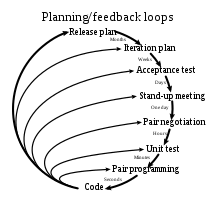
Figure 1: Extreme Programming Methodology
Figure 1: Shows Extreme Programming theDiagram used by the proponents as their model for the system. It shows how Extreme Programming’s rules work together. A preference for effective action based on other principles so that the results aren’t harmful to the team. Extreme Programming is a software development framework that aims to produce higher quality software, and higher quality of life for the development team.
XP stresses the importance of the appropriate kind of communication that is face to face discussion with the aid of a white board or other drawing mechanism. The diagram shows the team sport that relies on communication to transfer knowledge from one team member to everyone else on the team. The advantage of XP model from the other methodologies avoid waste and do only absolutely necessary things such as keep the design of the system as simple as possible so that it is easier to maintain, support, and revise.
Release Plan
In this phase, the proponents used Release Plan meeting to create a release plan, which lays out the overall project for DLT Pharmacy. They will commit themselves to the functionality that will be included and the date of the next release.
Iteration Plan
The proponent plans the activities and tasks of the developers and decides what content goes into specific iterations. The tasks will be assigned to the proponents and the time it takes to complete will be estimated. The proponents plan by selecting Stories from the team backlog and committing to execute a set of them in the upcoming iteration.
The proponent’s backlog has been seeded and partially planned during the Program Increment (PI) Planning meeting. In addition, the Proponent has feedback not only from their prior iterations but from the System Demo and other proponents. That, and the natural course of changing fact patterns, provides the broader context for iteration planning.
Acceptance Test
The Proponent use acceptance tests as a complement to specification documents containing uses cases or more narrative text. Proponents write as many automated tests as much as possible, and if all of them prove to be successful, then the coding is regarded to be complete.
Besides, every piece of code which is written is tested thoroughly before going ahead with the next feature. Acceptance testing is done to ascertain that the programmers understand the requirements and in turn can satisfy the actual requirements of DLT Pharmacy.
Stand Up Meeting
The Proponent report at least three things; what was accomplished yesterday, what will be attempted today, and what problems are causing delays.
Pair Negotiation
The Proponent combines two sets of skills for design and implementation to yield the best solution.
Unit Test
The Proponent takes a bit of time to test virtually every line of code when it is written, what is the probability of missing a defect at that point. Proponent do unit testing, they tend to find defects much earlier, resulting in a more cost effective way to eliminate defects.
Pair Programming
The Two Proponent working together at a single computer. Effectively get a continuous code review and quicker response to nagging problems that may stop one person dead in their tracks. Proponent used pair programming to improve quality and does not actually take twice as long because they are able to work through problems quicker and they stay more focused on the task at hand, thereby creating less code to accomplish the same thing.
Code
Each pair of proponent writes their code and then integrates it together. The development team has a collective code ownership. Each proponent can change or refactor any part of the code. It ensures that no one developer becomes a bottleneck for changes and it allows proponents to reuse any functionality that might be required by multiple user stories.
Use Case Diagram of Online Delivery Design and Methodology Documentation
The use case diagram showed the user’s interaction with the system and its relationship between different use cases and the users involved.
Online Medicine Delivery System with SMS notification

Figure 2. Online Medicine Delivery Use Case Diagram with SMS Notification.
Figure 2 Showed the major task that the actor must be done to implement the system. As the figure showed, Admin could manage user account and reports, And Employee were responsible for delivery.
Figure 3. Manage Order Use Case Diagram

This use case diagram is more like to purchased products online.
Table 2: Manage Order Use Case Description
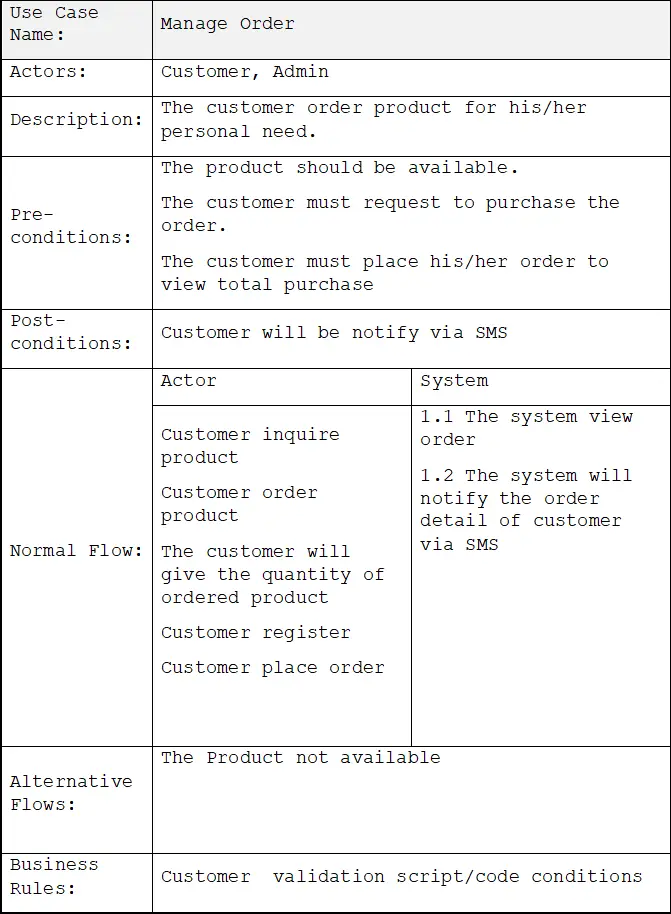
Manage Delivery

Figure 4. Manage Delivery Use Case Diagram
This use case diagram includes systems that manage delivery entry processed by the Rider and forwarded to Customer who order the product.
Table 3: Manage Delivery Use Case Description
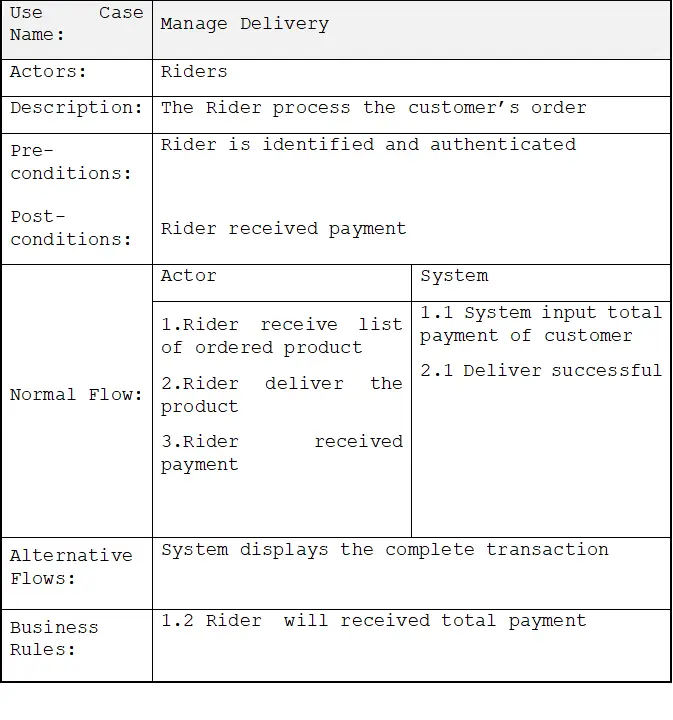
Manage Rider

Figure 5. Manage Rider Use Case Diagram
This use case diagram includes systems that manage the rider to assign at any location to deliver products.
Table 4: Manage Rider Use Case Description
Manage Product

Figure 6. Manage Product Use Case Diagram
Table 5: Manage Product Use Case Description
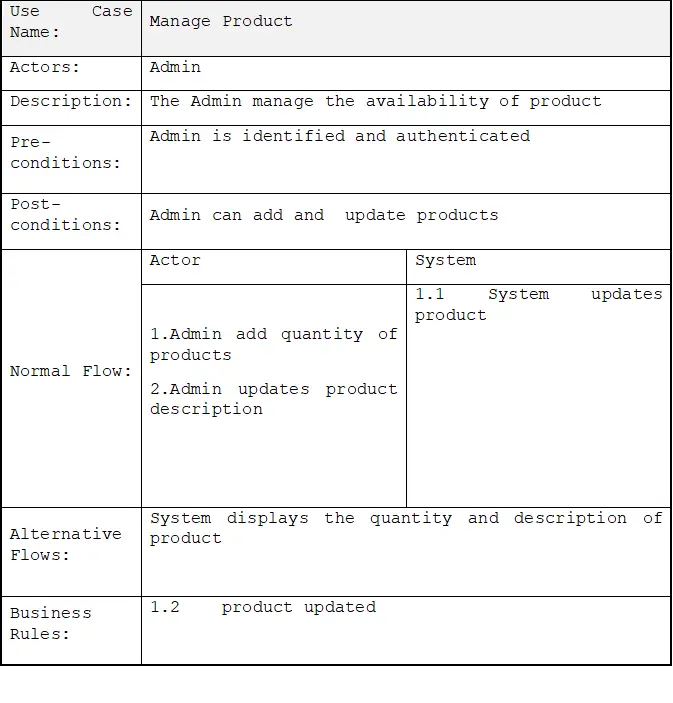
Activity Diagram for Online Delivery Design and Methodology Documentation
The activity diagram showed the flow of Online Medicine Delivery System with SMS Notification.
This use case diagram includes systems that manage Product entry processed by Admin.
Admin Activity Diagram

Figure 7. Admin Activity Diagram
Shows the steps of admin create user details.
Customer Activity Diagram

Figure 8. Customer Activity Diagram
Showed the steps of customer ordering medicine via online for delivery process that includes the recognition of needs and wants.
Rider Activity Diagram

Figure 9. Rider Activity Diagram
Showed the process of delivery product upon receiving order of customer.
Functional Decomposition Diagram
The Decomposition Chart showed the breakdown process and its sub-processes of the whole system.

Figure 10. Functional Decomposition Diagram
Figure 10 showed the breakdown and its sub-processes of the develop system. Every process was being labeled and marked to equate the functionality of the whole system.
CONTEXT DIAGRAM of Online Medicine Delivery Documentation
The context diagram of Online Medicine Delivery System represented below shows the flow of the system throughout the system process. It shows what information could be input, where the data goes and how it is stored.

Figure 11. Context Diagram of the proposed System
Shows the general process of the develop system. It demonstrated the delivery information needed of the customer.
Online Delivery Design and Methodology Documentation Data Flow Diagram
Data flow Diagram of Proposed Solution showed the concept and flows of each entity, it showed the processes of the proposed system. Through this flow, the reader could easily identify which process which process to begin with.

Figure 12: Data Flow Diagram of Online Medicine Delivery System with SMS Notification
Showed the entire data flow, the processes, input requirements, processed output and the storage of the developed system.
Entity Relationship Diagram

Figure 13: Entity Relationship Diagram of Online Medicine Delivery System with SMS Notification
Showed the connection of all tables in the database. Each table required specific information in order for the system works.
Data Dictionaries Online Delivery Design and Methodology Documentation
These tables below provide the entire database tables details such as Field Name, Descriptions, data types, character lengths.
Table 6: Table Messagein
| Field Name | Description | Type | Length |
| Id (PK) | Id Number | Int | 11 |
| SendTime | Send Time | Datetime | |
| ReceiveTime | Receive Time | Datetime | |
| MessageFrom | Message From | Varchar | 80 |
| MessageTo | Message To | Varchar | 80 |
| SMCS | SMCS | Varchar | 80 |
| MessageText | Message Text | Text | |
| MessageType | Message Type | Varchar | 80 |
| MessageParts | Message Parts | Int | 11 |
| MessagePDU | Message PDU | Text | |
| Gateway | Gateway | Varchar | 80 |
| UserId | User Id | Varchar | 80 |
Table 6: This table show the attributes of entity of Messagein
Table 7: Table Messagelog
| Field Name | Description | Type | Length |
| Id (PK) | Id | Int | 11 |
| SendTime | SendTime | datetime | |
| ReceiveTime | Receive Time | datetime | |
| StatuCode | Status Code | Int | 11 |
| StatusText | Status Text | Varchar | 80 |
| MessageTo | Message To | Varchar | 80 |
| MessageFrom | Message From | Varchar | 80 |
| MessageText | Message Text | Text | |
| MessageType | Message Type | Varchar | 80 |
| MessageId | Message Id | Varchar | 80 |
| ErrorCode | Error Code | Varchar | 80 |
| ErrorText | Error Text | Varchar | 80 |
| Gateway | Gateway | Varchar | 80 |
| MessageParts | Message Parts | Int | 11 |
| MessagePDU | Message PDU | Text | |
| Connector | Connector | Varchar | 80 |
| UserId | User Id | Varchar | 80 |
| UserInfo | User Info | Text |
Table 7: This table show the attributes of entity of Messagelog
Table 8: Table Messageout
| Field Name | Description | Type | Length |
| Id (PK) | Id | Int | 11 |
| MessageTo | MessageTo | Varchar | 80 |
| MessageFrom | MessageFrom | Varchar | 80 |
| MessageText | MessageText | Text | |
| MessageType | MessageType | Varchar | 80 |
| Gateway | Gateway | Varchar | 80 |
| UserId | UserId | Varchar | 80 |
| UserInfo | Userinfo | Text | |
| Priority | Priority | Int | 11 |
| Scheduled | Schedule | datetime | |
| ValidityPeriod | ValidityPeriod | Int | 11 |
| IsSent | IsSent | Tinyint | 1 |
| IsRead | Messageout IsRead | Tinyint | 1 |
Table 8: This table show the attributes of entity of Messageout
Table 9: Table tblautonumber
| Field Name | Description | Type | Length |
| ID (PK) | ID | Int | 11 |
| AUTOSTART | AUTOSTART | Varchar | 80 |
| AUTOINC | AUTOINC | Int | 11 |
| AUTOEND | AUTOEND | Int | 11 |
| AUTOKEY | AUTOKEY | Varchar | 12 |
| AUTONUM | AUTONUM | Int | 11 |
Table 9: This table show the attributes of entity of tblautonumber
Table 10: Table tblcategory
| Field Name | Description | Type | Length |
| CATEGID (PK) | Category Id | Int | 11 |
| CATEGORIES | Category name | Varchar | 80 |
| USERID | userid | Int | 11 |
Table 10: This table show the attributes of entity of tblcategory
Table 11: Table tblcustomer
| Field Name | Description | Type | Length |
| CUSTOMERID (PK) | customer id | Int | 11 |
| FNAME | customer first name | Varchar | 30 |
| MNAME | customer middle name | Varchar | 30 |
| LNAME | customer last name | Varchar | 30 |
| HOMEADDRESS | customer home address | Text | |
| DELADDRESS | customer delivery address | Text | |
| GENDER | customer gender | Varchar | 10 |
| PHONE | customer contact number | Varchar | 20 |
| CUSUNAME | customer username | Varchar | 20 |
| CUSPASS | customer password | Varchar | 90 |
| TERMS | customer terms | tinyint | 4 |
| DATEJOIN | customer date join | date |
Table 11: This table show the attributes of entity of tblcustomer
Table 12: Table tbllocation
| Field Name | Description | Type | Length |
| LOCID (PK) | Location Id | Int | 11 |
| PLACE | Municipality/city | Varchar | 90 |
| BRGY | barangay | Varchar | 90 |
| DELPRICE | Delivery price | double |
Table 12: This table show the attributes of entity of tbllocation
Table 13: Table tblorder
| Field Name | Description | Type | Length |
| ORDERID (PK) | Order Id | Int | 11 |
| PROD | Product Name | Int | 11 |
| ORDEREDQTY | Ordered quantity | Int | 11 |
| ORDEREDPRICE | Ordered price | double | |
| ORDEREDNUM | Ordered number | Int | 11 |
| CUSTOMERID | Customer id | Int | 11 |
| EMPID | Employee id | Int | 11 |
| PRESCRIBEDQTY | Prescribed quantity | Int | 3 |
Table 13: This table show the attributes of entity of tblorder
Table 14: Table tblproduct
| Field Name | Description | Type | Length |
| PRODID (PK) | Product Id | Int | 11 |
| PRONAME | Product name | Varchar | 80 |
| PRODESC | Product description | Text | |
| PROQTY | Product quantity | Int | 11 |
| ORIGINALPRICE | Product original price | Double | |
| PROPRICE | Product price | Double | |
| CATEGID | Product category id | Int | 11 |
| IMAGES | Product images | Varchar | 80 |
| PROSTATS | Product status | Varchar | 80 |
Table 14: This table show the attributes of entity of tblproduct
Table 15: Table tblemployee
| Field Name | Description | Type | Length |
| EMPID (PK) | Employee Id | Int | 11 |
| LNAME | Employee last name | Varchar | 80 |
| MNAME | Employee middle name | Varchar | 80 |
| FNAME | Employee first name | Varchar | 80 |
| DOB | Employee Birthday | Date | |
| AGE | Employee age | Int | 11 |
| SEX | Employee gender | Varchar | 80 |
| ADDRESS | Employee address | Text | |
| Employee email | Varchar | 80 | |
| PASSWORD | Employee password | Varchar | 80 |
| CONTACT | Employee contact number | Varchar | 11 |
| IMAGE | Employee image | Text | 90 |
| Total_delivered | Employee total delivered | Int | 30 |
Table 15: This table show the attributes of entity of tblemployee
Table 16: Table tblsummary
| Field Name | Description | Type | Length |
| SUMMARYID (PK) | Summary Id | Int | 11 |
| ORDEREDDATE (FK) | Ordered date | Date/Time | |
| CUSTOMERID | Customer id | Int | 11 |
| IMAGE | Product image | Varchar | 80 |
| ORDEREDNUM | Ordered number | Int | 11 |
| DELFEE | Delivery fee | Double | |
| PAYMENT | Payment | Double | |
| PAYMENTMETHOD | Payment method | Varchar | 80 |
| ORDEREDSTATS | Ordered status | Varchar | 80 |
| ORDEREDREMARKS | Ordered remarks | Varchar | 80 |
| CLAIMEDDATE | Claimed date | Date/Time | |
| EMPID | Employee id | Int | 11 |
| USERID | User id | Int | 11 |
Table 16: This table show the attributes of entity of tblsummary
Table 17: Table tbluseraccount
| Field Name | Description | Type | Length |
| USERID (PK) | User Id | Int | 11 |
| U_NAME (FK) | User name | Varchar | 80 |
| U_USERNAME | User username | Varchar | 80 |
| U_PASS | User password | Varchar | 80 |
| U_ROLE | User role | Varchar | 80 |
| USERIMAGE | User image | Varchar | 80 |
Table 17: This table show the attributes of entity of tbluseraccount
Table 18: Table tblwishlist
| Field Name | Description | Type | Length |
| id (PK) | Wishlist Id | Int | 11 |
| CUSID (FK) | Customer Id | Int | 11 |
| PROID | Product id | Int | 11 |
| WISHDATE | Wishlist date | date | |
| WISHSTATS | Wishlist status | text |
Table 18: This table show the attributes of entity of tblwishlist.
System Screen Layout
The screen layout of “Online Medicine Delivery System with SMS Notification”.
Customer Side Interface
This picture shows the interface of Customer Side Home

Figure 14: Screen Design for Client Side Home
Category Interface
This picture shows the interface of Category

Figure 15: Screen Design for Category Interface
Medicine Interface
This picture shows the interface of medicine

Figure 16: Screen Design of Medicine Interface
Add to Cart
This picture shows the interface of Add to Cart

Figure 17: Screen Design for Add to Cart
Submit Order
This picture shows the interface of Submit Order

Figure 18: Screen Design for Submit Order
List of Orders
This picture shows the interface of List of Orders

Figure 19: Screen Design for List of Orders
Admin Side Interface
List of Employee
This picture shows the interface of List of employee

Figure 20: Screen Design for List of Employee
Add Employee
This picture shows the interface of List of employee

Figure 21: Screen Design for Add Employee
Update Employee
This picture shows the interface of Update of Employee

Figure 22: Screen Design for Update Employee
List of Products
This picture shows the interface of List of products

Figure 23: Screen Design for List of Products
Add New Product
This picture shows the interface of Add New Product

Figure 24: Screen Design for Add New Products
Update Product
This picture shows the interface of Update Product

Figure 25: Screen Design for Update Products
List of Orders
This picture shows the interface of List of Orders

Figure 26: Screen Design for List of Orders
List of Categories
This picture shows the interface of List of Categories

Figure 27: Screen Design for List Of Categories
Add New Category
This picture shows the interface of Add New Category

Figure 28: Screen Design for Add New Category
List of User
This picture shows the interface of List of Users

Figure 29: Screen Design for List of User
Add New User
This picture shows the interface of Add New Users

Figure 30: Screen Design for Add New User
Report
This picture shows the interface of List of Report

Figure 31: Screen Design for Reports
Commission
This picture shows the interface of List Commission

Figure 32: Screen Design for Commission
Rider Side Interface
This picture shows the interface of Rider side

Figure 33: Screen Design for Rider Side Interface
ARCHITECTURAL DIAGRAM of Online Delivery Design and Methodology Documentation

Figure 34: Architectural Diagram
System Requirements of Thesis Project Online Medicine Delivery System
Developing “Online Medicine Delivery System with SMS Notification” is not an easy task. It all started from the requirement gathering and passes through so many other stages before it will be implemented.
Based on the benefits of this system and tremendous value it will add to customer-user satisfaction, the below recommendation will be considered;
It is recommended that the new system should be used with the necessary specifications of the system requirements and provision for an uninterrupted power supply should be made available throughout the hours of operation of the pharmacy to avoid power outage. There should also be basic computer knowledge for the users of the developed system.
The following is the list of hardware and software that was used in the development and the recommended software and hardware for deployment for the system to run smoothly.
Hardware Requirements
Recommended Hardware Requirement for Development:
Computer Intel Core i5 7th Generation Processor
Hard Disk: 240GB SSD SanDisk Plus
RAM: 4GB DDR4 2133Mhz
Intel HD Graphics 620mx
NVIDIA GeForce 940MX 2GB
Mouse 2 button with scroll
Laptop LCD 14”
Keyboard
Software Requirements
Software Requirement for Development:
HeidiSQL v9.5.0.5273 (64-bit)
Sublime 3.0 (32/64-bit)
XAMPP v3.2.2 (32/64-bit)
Framework Codeigniter v3.1.5
Google Chrome v69.0.3497.100 (Official Build) (64-bit)
Online Delivery Design and Methodology Documentation Gantt Chart
The Gantt Chart assesses the proponents with the project management throughout the whole Process. It caters of how long the process will take that allow time management effectively. The minimum delivery time of this Online Medicine Delivery Documentation was being figure out means of Gantt chart.

Figure 35: Gantt chart
Conclusion
This Thesis Project Online Medicine Delivery System is for students in order for them to have an idea on what to write in their own Chapter 3 Methodology.
Feel free to leave your comments down below. For other great articles, click the links below.
- CHMSC Binalbagan IT Freshmen Admission System Thesis Chapter 3
- Library Borrowing System Documentation | Chapter 1 – Introduction
- Library Borrowing System Documentation | Chapter 2 – Review of Related Literature
- Library Management System Free Source Code
- Best PHP Projects With Source Code Free Download
- DBMS Mini Projects Topics for Students 2019
- Online Medicine Delivery System Documentation Chapter 1
- Online Medicine Delivery System Documentation Chapter 2

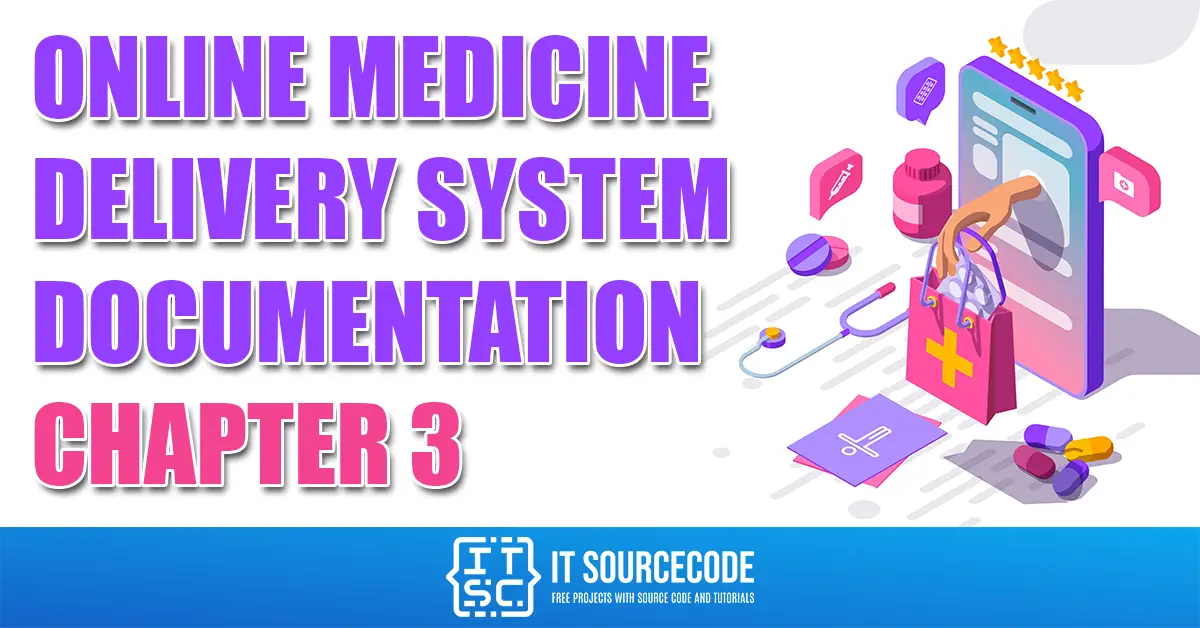

This app has a user friendly interface. It has really great service of quick delivery. All the prices are affordable and there are regular discounts on the medicines so that i doesn’t face any type of difficulty in purchasing the required medications.
thank you for the great post.